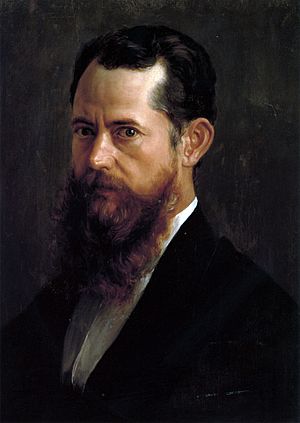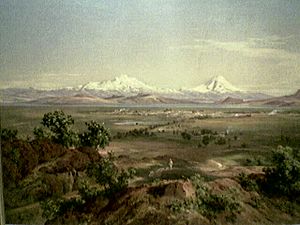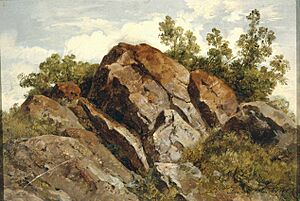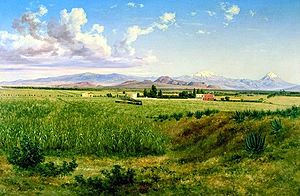José María Velasco Gómez facts for kids
Quick facts for kids
José María Velasco Gómez
|
|
|---|---|

Self-Portrait, 1894, Museo Nacional de Arte
|
|
| Born |
José María Tranquilino Francisco de Jesús Velasco Gómez Obregón
6 July 1840 Temascalcingo, Mexico Department, Centralist Republic of Mexico
|
| Died | 26 August 1912 (aged 72) Villa de Guadalupe, Mexico City, Mexico
|
| Nationality | Mexican |
| Education | Academy of San Carlos |
| Known for | Painting, landscapes and portraits |
|
Notable work
|
El valle de México |
José María Velasco (born July 6, 1840, died August 26, 1912) was a very famous Mexican painter. He lived in the 1800s and early 1900s. He is best known for his amazing landscape paintings.
Velasco's art helped show the beauty of Mexican geography. His paintings made the landscapes of Mexico a symbol of the country's identity. He was popular in Mexico and around the world.
He won many awards for his art. These included gold medals at Mexican art shows in 1874 and 1876. He also won a gold medal at an international show in Philadelphia in 1876. In 1889, he received a medal at the Paris Universal Exposition.
His most famous painting is El valle de México (The Valley of Mexico). He painted this scene seven different times! Velasco was seen as a very important artist who helped define Mexican art.
Contents
José María Velasco's Art Career
José María Velasco studied art at the Academy of San Carlos in Mexico. His teacher was Eugenio Landesio, an Italian artist. Landesio taught landscape painting starting in 1855.
Landesio helped make landscape painting a respected art form in Mexico. Velasco became his most famous student. After Landesio left in 1877, Velasco became the top landscape painter in Mexico. His works were even collected in the United States.
Velasco's painting career can be divided into three main parts:
Early Academic Years (1860-1889)
During this time, Velasco painted many famous scenes. These include La Plaza de San Jacinto en San Ángel and Las montañas de la Magdalena. He also painted La Alameda de México and El bosque de Jalapa. Other works from this period are El Cedro de Chimalistac and El Ahuehuete de Chapultepec.
Impressionist Influence (1890-1892)
In this short period, Velasco was influenced by French Impressionists. These artists used light and color in new ways. Paintings from this time include Valle de Mexico desde el cerro de Atraeualco. He also painted Ajusco visto desde el Tepeyac.
Personal Style (1892-1912)
This was Velasco's final period of painting. His works include Rocas del cerro de Atzacoalco. He also painted Pirámide del Sol en Teotihuacán, Popocatepetl, and Ixtlaciual. Other notable paintings are Templo de San Bernardo, Cascada de Necaxa, and El Puente de Metlac.
In 1893, Velasco went to Chicago. He was a special art representative for Mexico at the 1893 World's Columbian Exposition. He showed seventeen of his own oil paintings there.
Velasco's Interest in Science
Velasco was not just an artist; he was also very interested in science. While studying at the Academy of San Carlos, he also learned about zoology (animals) and botany (plants). He studied these subjects at a nearby medical school.
He also learned mathematics, geology, and surveying. In 1879, he discovered a new type of salamander. It was found in Santa Isabel lake, near Mexico City. He wrote about his discovery in a Mexican science magazine.
He named the new species Siredon Tigrina. Later, another scientist, Alfredo Dugès, renamed it Ambystoma velasci in Velasco's honor. This salamander is also known as the Plateau Tiger Salamander.
In 1997, two botanists named a new plant after him. The plant is called Velascoa. It is a type of flowering plant found in northeastern Mexico.
Velasco's Lasting Impact
José María Velasco's long career made Mexican landscape painting famous worldwide. One of his paintings of the Valley of Mexico is even in the Vatican Museum. It was a gift to Pope Leo XIII.
His paintings of the Mexican landscape are very important today. They show how the Valley of Mexico looked before it changed a lot. They show the area before air pollution and big cities spread out.
His art is popular because it is easy to understand. You don't need to know a specific historical event to enjoy his beautiful landscapes.
Today, the Government of the State of Mexico gives an award in his name. This award is for painters born in that state. Famous winners include Luis Nishizawa and Leopoldo Flores.
The José María Velasco Museum opened in 1992 in Toluca. Its job is to protect and share his amazing paintings with everyone.
Gallery
-
Estudio de una víbora.
-
Estudio de pensamientos.
-
Ahuehuete de la noche triste.
-
Valle de México desde el cerro de Santa Isabel.
See also
 In Spanish: José María Velasco Gómez Obregón para niños
In Spanish: José María Velasco Gómez Obregón para niños















